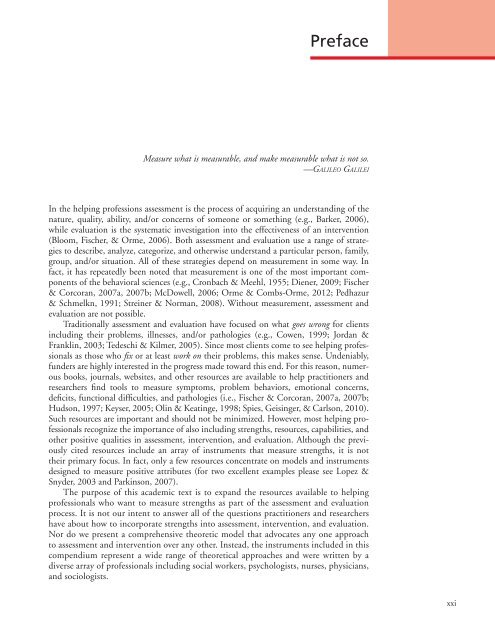Tools for Strengths-Based Assessment and Evaluation - Springer ...
Tools for Strengths-Based Assessment and Evaluation - Springer ...
Tools for Strengths-Based Assessment and Evaluation - Springer ...
Create successful ePaper yourself
Turn your PDF publications into a flip-book with our unique Google optimized e-Paper software.
Preface<br />
Measure what is measurable, <strong>and</strong> make measurable what is not so.<br />
—GALILEO GALILEI<br />
In the helping professions assessment is the process of acquiring an underst<strong>and</strong>ing of the<br />
nature, quality, ability, <strong>and</strong>/or concerns of someone or something (e.g., Barker, 2006),<br />
while evaluation is the systematic investigation into the effectiveness of an intervention<br />
(Bloom, Fischer, & Orme, 2006). Both assessment <strong>and</strong> evaluation use a range of strategies<br />
to describe, analyze, categorize, <strong>and</strong> otherwise underst<strong>and</strong> a particular person, family,<br />
group, <strong>and</strong>/or situation. All of these strategies depend on measurement in some way. In<br />
fact, it has repeatedly been noted that measurement is one of the most important components<br />
of the behavioral sciences (e.g., Cronbach & Meehl, 1955; Diener, 2009; Fischer<br />
& Corcoran, 2007a, 2007b; McDowell, 2006; Orme & Combs-Orme, 2012; Pedhazur<br />
& Schmelkn, 1991; Streiner & Norman, 2008). Without measurement, assessment <strong>and</strong><br />
evaluation are not possible.<br />
Traditionally assessment <strong>and</strong> evaluation have focused on what goes wrong <strong>for</strong> clients<br />
including their problems, illnesses, <strong>and</strong>/or pathologies (e.g., Cowen, 1999; Jordan &<br />
Franklin, 2003; Tedeschi & Kilmer, 2005). Since most clients come to see helping professionals<br />
as those who fix or at least work on their problems, this makes sense. Undeniably,<br />
funders are highly interested in the progress made toward this end. For this reason, numerous<br />
books, journals, websites, <strong>and</strong> other resources are available to help practitioners <strong>and</strong><br />
researchers find tools to measure symptoms, problem behaviors, emotional concerns,<br />
deficits, functional difficulties, <strong>and</strong> pathologies (i.e., Fischer & Corcoran, 2007a, 2007b;<br />
Hudson, 1997; Keyser, 2005; Olin & Keatinge, 1998; Spies, Geisinger, & Carlson, 2010).<br />
Such resources are important <strong>and</strong> should not be minimized. However, most helping professionals<br />
recognize the importance of also including strengths, resources, capabilities, <strong>and</strong><br />
other positive qualities in assessment, intervention, <strong>and</strong> evaluation. Although the previously<br />
cited resources include an array of instruments that measure strengths, it is not<br />
their primary focus. In fact, only a few resources concentrate on models <strong>and</strong> instruments<br />
designed to measure positive attributes (<strong>for</strong> two excellent examples please see Lopez &<br />
Snyder, 2003 <strong>and</strong> Parkinson, 2007).<br />
The purpose of this academic text is to exp<strong>and</strong> the resources available to helping<br />
professionals who want to measure strengths as part of the assessment <strong>and</strong> evaluation<br />
process. It is not our intent to answer all of the questions practitioners <strong>and</strong> researchers<br />
have about how to incorporate strengths into assessment, intervention, <strong>and</strong> evaluation.<br />
Nor do we present a comprehensive theoretic model that advocates any one approach<br />
to assessment <strong>and</strong> intervention over any other. Instead, the instruments included in this<br />
compendium represent a wide range of theoretical approaches <strong>and</strong> were written by a<br />
diverse array of professionals including social workers, psychologists, nurses, physicians,<br />
<strong>and</strong> sociologists.<br />
xxi

















